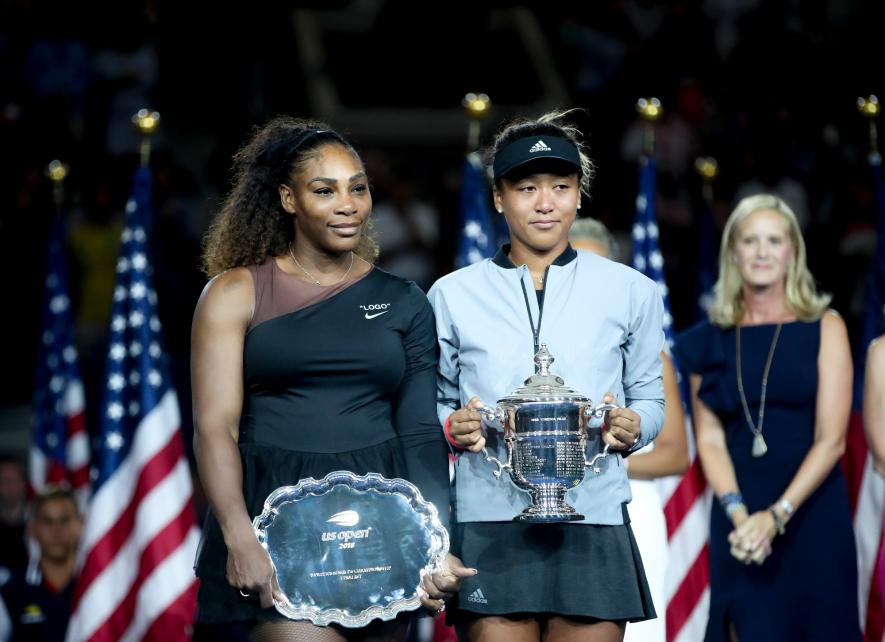US Open: Champion is Naomi Osaka, Lest We Forget in the Serena Williams Furore

Naomi Osaka with the US Open 2018 trophy, flanked by Serena Williams after the presentation ceremony at Arthur Ashe Stadium on September 9. Osaka’s moment of triumph was, however, marred by booing from the crowd (Pic: IANS).
Novak Djokovic won the US Open last evening (September 9), an overhead smash past Juan Martin Del Potro wrapping up his 14th Grand Slam. He collapsed on his back, his arms spread out, eyes closed, as the emotions took over. The crowd roared in approval. The words “US Open Champion” flashed on the neon sign boards across the Arthur Ashe stadium in New York.
After ages, it seemed, he got up and embraced his good friend, fellow struggler, fellow professional and gracious loser Del Potro at the net. The crowd roared louder. Even the most ardent Del Potro fan — of which there were many — couldn’t deny the winner his moment. They roared in approval, and clapped and cheered the victor the way he deserved to be lauded.
Naomi Osaka also deserved all that and more.
Not 24 hours earlier, the 20-year-old Japanese player had put on a similar masterclass against one of the greatest players of this generation, Serena Williams, and when she walked to the net as the victor, she did so to a crescendo of boos and whistles (there were some cheers, of course). The booing, though, was so much that she had to apologize for winning at all in her acceptance speech.
Also Read | India at Asian Games 2018: The Truth Behind Government's Claims
Osaka deserved to feel happy. She deserved to be cheered, and roared at, heralded as perhaps the new star of women’s tennis. In the moment, at the moment of her triumph, everyone inside Arthur Ashe Stadium denied her that joy. Too much of the aftermath was focused on an umpire, a raging beaten opponent and a controversy that will carry on for weeks. Too little was about Osaka’s victory.
There is a serious danger of this piece taking a turn here, becoming another one that talks about the raging fire that has followed the spectacle of the women’s final at the US Open. It could, on that path, also argue, for, against or even just point out, the inherent flaws in the modern rules of tennis, the inherent sexism that exists across sport today, and the subjectivity that human umpires bring to sport (replace them with robots, we say. Replace the players too. The journalists shall follow).
It could even veer off and talk about Osaka’s opponent — completely outplayed, and outclassed (not just on court) — and everything she achieved and missed out on September 8.
But it won’t. Because Naomi Osaka deserves her moment.
There has to be a mention of Serena Williams in Osaka’s story, because, regardless of the US Open final, her journey features Williams prominently. Their similarities are too much to ignore. And yet, their differences are too much to bear.
Also Read | Rafael Nadal's Feat of Clay: 11th French Open Crown and Other Records
Osaka has an elder sister, Mari, who was considered the more talented for the majority of their childhood. Their father Francois, took the Richard Williams playbook, and applied it to the childhood of his Haitian-Japanese daughters. He taught them to serve big, and hit hard from all parts of the court. “The blueprint was already there. I just had to follow it,” says Francois in Brooke Lamar’s profile piece on the US Open champion.
Osaka herself spares no effort in pointing out her love for Serena. In the past, she has serenaded her through Instagram posts, and more recently in on-court interviews.
Osaka’s game is essentially modelled around Serena’s. They both have powerful, pull-me-out-of-trouble serves, spectacular lateral movement, and forehands that, when they don’t catch the line, veer dangerously towards causing ball boys harm.
That is where the similarities end.
Also Read | Hockey ‘Expands’ at Asian Games, the Game Goes Down
Osaka is, in every other way possible, diametrically opposite to Serena. In the battle of cultures raging inside her young mind, outside the court, in her daily life, ever so often her Japanese side wins out. She watches Pokemon and liberally quotes its theme song as an inspiration — to the bafflement of many, it must be said. She painstakingly apologises to partisan fans when she beats home favourites, and always has a swift, subtle yet unmissable bow at the net acknowledging her opponent. Her game on court is modelled after Serena, but her behaviour is stereotypically ‘Japanese’. She is not hugely expressive, very gracious, and respectful towards everyone around her all time.
Osaka’s US Open victory is an important reflection of her time. She challenges our assumptions and understanding of what and when a biracial person can be accepted as who they are. In Lamar’s piece, the author frequently quotes Japanese players and coaches who admit to not considering her to be pure Japanese. In the aftermath of her US Open victory, The New York Times’ newest feature amended that wrong by quoting people who agreed, that ‘her face is Japanese’. The hypocrisy is all too scripted.
Even here the Serena parallels must be drawn clearly. Now it seems normal, but the Williams sisters have redefined the way we view women’s tennis. Over the course of the last two decades, they have defined, redefined and constantly reaffirmed what it means to be a woman athlete (they have muscles), a black tennis player (a rare occurrence before them), and serial winners.
Also Read | Corruption and Mismanagement Rule Indian Sport; Kabaddi's Story at the Asian Games Tells Us Why
Osaka, then, is just an evolution of that theme. Black acceptance has become biracial acceptance. In an increasingly shrinking world, this theme is rarely addressed with authority. Osaka does it superbly. Not just off court, but even on it. Osaka’s dismantling of Serena’s game in the final was an evolution of power tennis. Strength, technique and mental fortitude, met strength, technique and mental fortitude. Youth met experience. And youth won. Arthur Ashe stadium failed to acknowledge this appropriately.
We must, though. And we should love it as well.
Highs and Lows in New York
-
Now, the meat. The umpire, Carlos Ramos, may have been over zealous, but seems to have made the correct call in docking points off Serena and calling the violations. He has an history, though, and may need to take a long look at himself, and his desire for attention in important matches.
-
Serena Williams is right about sexism in sport. She is wrong about Saturday though. She didn’t immediately, on court, choose to confront and abuse the umpire, because she felt she was targeted. She did it because she let her emotions get the better of her. There is history here, for her, at the same tournament. She did it to manipulate the emotions of a biased crowd against a wholly innocent opponent. It shouldn’t be condoned, but accepted. Players are human beings. Human beings have emotions (replacing them with robots will be great for everyone involved). While, in the heat of the moment it could be excused (a lot of players male and female do this), her inability to acknowledge this, and instead try and obfuscate it within a larger cause is regrettable. Champions of her calibre show sportsmanship more than anything else. It has been a criticism often lobbed at her, and this evidence — despite the cooling off of controversies in recent times — will be used to flay her otherwise impeccable character.
-
The Djoker is back.
-
Robot vs humans to decide who plays sport from now on.
(The views expressed are personal)
Get the latest reports & analysis with people's perspective on Protests, movements & deep analytical videos, discussions of the current affairs in your Telegram app. Subscribe to NewsClick's Telegram channel & get Real-Time updates on stories, as they get published on our website.
























